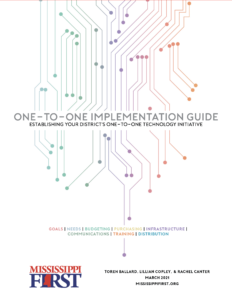- Future of Schools
Mississippi schools have a once-in-a-lifetime opportunity. Every student now has access to a device, and the state is working to expand broadband access. These circumstances make it the right time for districts to establish a one-to-one technology initiative.
Major Takeaways
The value of integrating digital learning tools into the instructional programs of pre-K-12 schools is clear: when used correctly, these tools—everything from laptops and tablets to learning management systems—can foster innovation and improve communication. A strong one-to-one plan can build trust and demonstrate the district’s commitment to providing an interactive and individualized learning environment for all.
The guide is organized into eight steps, designed to meet districts where they are. Here is a checklist to use when strategizing your one-to-one technology plan.

Step 1: Goals
The first step walks schools through the goal-setting process, ensuring that schools are intentionally integrating digital learning tools into their instructional programs and that districts are deliberate in articulating what exactly they hope to achieve by placing a device in the hands of every student.

Step 2: Needs
Step 2 is dedicated to assessing the district’s needs in relation to overall technology capacity, including one-to-one devices, internet connectivity, device security, and a learning management system (LMS).

Step 3: Budgeting
Step 3 provides budgeting guidelines for both one-time and recurring costs.

Step 4: Purchasing
Step 4 helps districts understand how to go about selecting and purchasing equipment and tools for their one-to-one initiative.

Step 5: Infrastructure
For a one-to-one technology initiative to be implemented seamlessly and effectively, districts must ensure that key “digital infrastructure” components—internet connectivity, device security, and an LMS—are in place.

Step 6: Communication
Communication is key, especially with so much uncertainty surrounding the pandemic.

Step 7: Training
Training educators to engage in the virtual space goes beyond developing knowledge and skills related to one-to-one technology. The extent to which teachers feel prepared will determine whether they have the confidence to ultimately make the leap into one-to-one integration.

Step 8: Distribution
Hand out devices with confidence. Your students, teachers, and families will have a new and powerful learning opportunity.
Authors

Rachel Canter
Executive DirectorRachel Canter is the Executive Director of Mississippi First and author of additional Mississippi First reports, including Leaving Last in Line, the State of Pre-K series, and Nothing in the Pipes: Educator Crisis in Mississippi (2020). Rachel founded Mississippi First in 2008.

Toren Ballard
Director of K-12 PolicyToren Ballard is the Director of K-12 Policy at Mississippi First and is a co-author of Nothing in the Pipes: Educator Crisis in Mississippi and the 2020 release of Public Perception of Charter Schools in Mississippi.

Lillian Copley
Education InternWhile working at Mississippi First, Lilly assisted the Director of K-12 Policy on the Establishing a One-to-One Technology guide—her first major publication. Lilly was an intern at Mississippi First while attending the University of Mississippi from 2020-2021.


